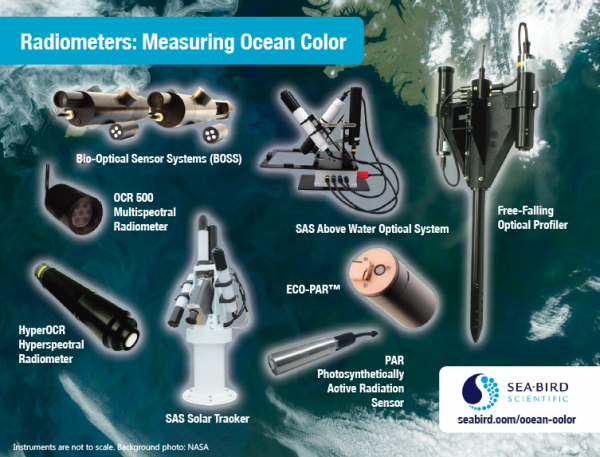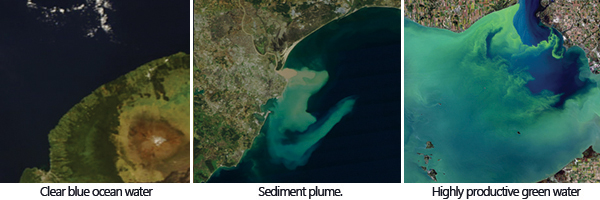- PRODUCTS
- MODEL LIST
- APPLICATIONS
- SUPPORT
- SALES/SERVICE
- BLOG
- ABOUT
Ocean Color Radiometry

The term “deep blue sea” isn’t always accurate. While pure seawater will scatter blue light back to the surface, the ocean consists of much more than just clear seawater. Particles in water absorb and reflect light, which means that as the particles change the ocean color changes. In the open ocean particles are mostly the living organisms of the oceanic ecosystem so repeatedly measuring the color of water tells us what is happening with the biology of the ocean. In coastal waters the color of water is a function of the biology and terrestrial inputs of particles and colored dissolved organic matter.
- Chlorophyll in phytoplankton absorbs blue wavelengths and reflects green wavelengths, turning productive waters green. Measuring the time rate of change in the intensity of the green wavelengths is an empirical measurement of primary productivity
- Clays and non living organic particles (including microplastics) reflect light across the visible spectrum so measuring the loss of light with depth across the spectrum is a measurement of the total particle load in the water
- Colored dissolved organic matter (CDOM) absorbs light primarily in the blue wavelengths that seawater reflects so high levels of CDOM can turn coastal waters black
The takeaway point: the ocean palette is a lot more than just blue, and observing the visible colors helps us paint a biogeochemical picture.
With precise and accurate measurements of ocean color the understanding and utility of ocean color expands. Sea-Bird Scientific offers a suite of instruments and systems that provide a lens into the world of ocean color, including radiometers with precision optics and deployment platforms designed specifically for optical sensors.

For more information, please see the following links to individual sensors and systems.
Radiometers:
- HyperOCR Hyperspectral Radiometer
- OCR 500 Multispectral Radiometer
- PAR Photosynthetically Active Radiation Sensor
- ECO-PAR™
Ocean Color Platforms
- Free-falling Optical Profiler
- Hyperspectral Shallow Water Profiling System
- SAS Above Water Optical System
Case Studies
- White Paper: Radiometer Calibration Transfer, Sea-Bird Scientific, September 2018

